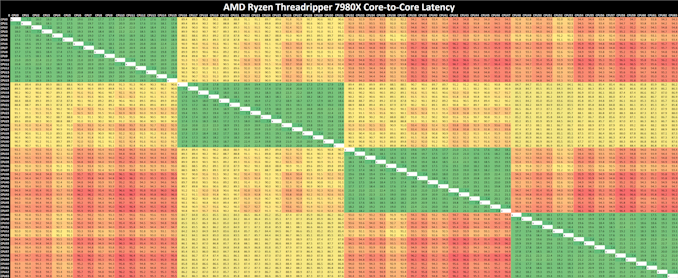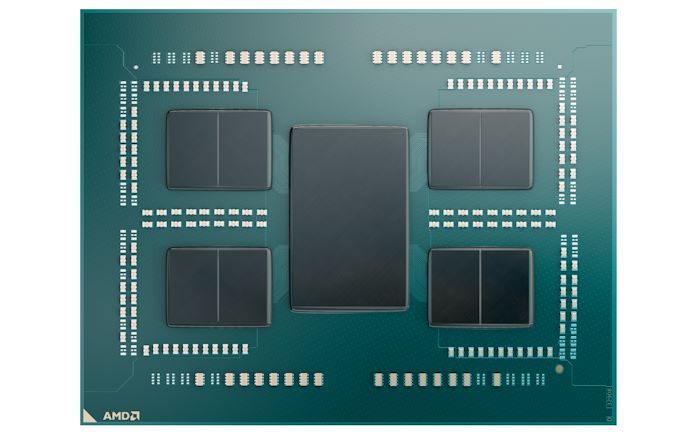AMD Ryzen Threadripper 7980X & 7970X Review: Revived HEDT Brings More Cores of Zen 4
by Gavin Bonshor on November 20, 2023 9:00 AM EST- Posted in
- CPUs
- AMD
- HEDT
- ThreadRipper
- Zen 4
- Threadripper 7000
- TRX50
Core-to-Core Latency
As the core count of modern CPUs is growing, we are reaching a time when the time to access each core from a different core is no longer a constant. Even before the advent of heterogeneous SoC designs, processors built on large rings or meshes can have different latencies to access the nearest core compared to the furthest core. This rings true especially in multi-socket server environments.
But modern CPUs, even desktop and consumer CPUs, can have variable access latency to get to another core. For example, in the first generation Threadripper CPUs, we had four chips on the package, each with 8 threads, and each with a different core-to-core latency depending on if it was on-die or off-die. This gets more complex with products like Lakefield, which has two different communication buses depending on which core is talking to which.
If you are a regular reader of AnandTech’s CPU reviews, you will recognize our Core-to-Core latency test. It’s a great way to show exactly how groups of cores are laid out on the silicon. This is a custom in-house test, and we know there are competing tests out there, but we feel ours is the most accurate to how quick an access between two cores can happen.

(Click on the image to enlarge)
Analyzing core-to-core latencies on the AMD Ryzen Threadripper 7980X (64C/128T), our test is limited to probing the first 64 threads, although scaling out to 128 threads would be identical. Each CCD on the Threadripper 7980X has 8 x Zen 4 cores, with 32 MB of L3 cache. Looking at the latency range within the CCD, we can see inner latencies between 7 and 20 ns, which increase to 89 and 96 ns as each core communicates within the CCX.

A visual render of the AMD Ryzen Threadripper 7980X with 8 x CCDs and IOD
Given we've reviewed the AMD Ryzen 9 7950X, which has the same Zen 4 cores and the same CCD complex approach to communicating between the cores, we see relatively similar latencies in both Threadripper 7000 and Ryzen 7000. A quad-channel DDR5 memory controller integrated within the large IOD and using PCIe 5.0 lanes as the primary pathway is important in enhancing the Infinity Fabric interconnect to reduce latencies and help counteract any penalties.










66 Comments
View All Comments
Jansen - Monday, November 20, 2023 - link
Bit disappointing that the memory controller only supports DDR5-5200, considering that JEDEC compliant DDR5-6400 RDIMMs are available.Ryan Smith - Monday, November 20, 2023 - link
At the end of the day it's the same I/O die as Genoa. So it comes with roughly the same restrictions.TEAMSWITCHER - Monday, November 20, 2023 - link
Not surprised by this at all. My 3960X Threadripper system was never able to run 64gb (16gb x 4) at even the promised DDR4-3200 speed. I tried three different RAM kits and even a different CPU (replaced by AMD) and the problem never went away. In the end I believe it to be motherboard issue, it was simply incapable of running stable with any RAM faster than DDR-3000.After spending so much on the ASUS Zenith II Extreme Alpha motherboard, 64GB of DDR-3600 RAM, and a $1400 CPU, the end result was very disappointing. Support from ASUS, AMD, and G-Skill was a long process, and eventually I had to just accept what was working and move on.
Ultimately, I don't believe that AMD and ASUS can properly deliver and support any HEDT platform that is worth the money they ask for it. I sincerely wish Intel would return to this segment, as I never had a problem with my X99 Deluxe II motherboard.
lemans24 - Monday, November 20, 2023 - link
Intel is definitely in HEDT with their xeon w-2400 chipsStormyParis - Monday, November 20, 2023 - link
I've blacklisted Asus. Lots of issues with both specs, reliability, and service.vfridman - Monday, November 20, 2023 - link
I have two systems with 3990X and two systems with 3970X, ASUS Zenith II Extreme Alpha motherboard and 256GB of 3600 speed G.Skill RAM in each system. All runs perfectly and completely stable, even with maxed out PBO overclock. I regularly run compilation jobs that require almost entire 256GB of RAM and never experienced any problems. I suspect you got unlucky with your CPU memory controller.Mikewind Dale - Tuesday, November 21, 2023 - link
I have a ThreadRipper Pro 3950X on a Supermicro WRX80 motherboard. I run 8x64 (512) GB of Supermicro-branded DDR4 3200 ECC RDIMM without a problem.Adam7288 - Wednesday, November 22, 2023 - link
Same exact config! Ram Bros.tygrus - Saturday, January 6, 2024 - link
How are you going with those >200GB matrices & statistics?Many years ago I had to use raw frequency stats, then a program to generate blocks of SAS code that could analyse cross-tab by cluster (weighted) with smaller subsets of interest from every possible combination (multi-morbidity data). Making sure the stats methods still gave correct results. Divide & conquer to fit in limited RAM of circa 2013 computers. In those days it was mostly constrained by single thread & disk/network IO speed (~100MB/s).
TEAMSWITCHER - Friday, November 24, 2023 - link
Ya know.. I have yet to build an AMD system that didn't suffer from some kind of issue. I don't think I'm unlucky either. I need to stop buying AMD gear thinking... "this time will be different." Because it never is.